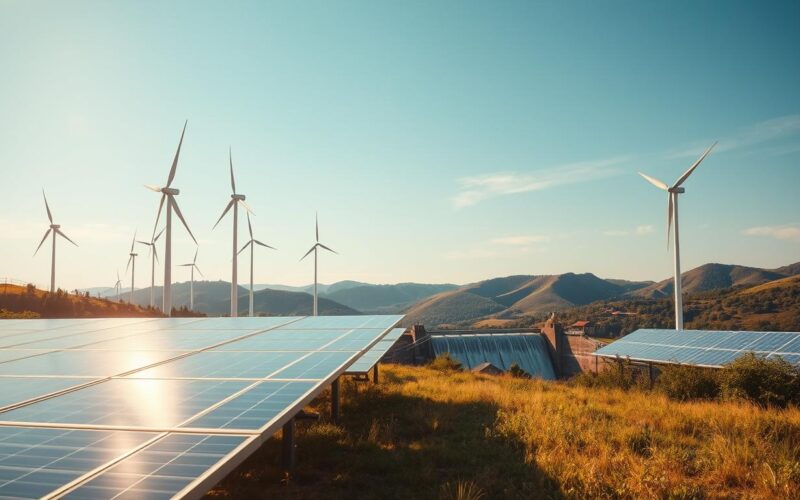Did you know that 30% of global electricity is currently generated from renewable sources1? This remarkable shift is transforming how we power our world, offering a cleaner, more sustainable alternative to traditional methods. Derived from natural, continuously replenished resources, renewable energy is not just a trend—it’s a necessity for a healthier planet.
Unlike fossil fuels, which account for 79% of total energy consumption, renewable energy sources produce little to no greenhouse gases1. This makes them crucial in combating climate change and reducing air pollution. The benefits extend beyond the environment, as the sector creates more jobs per unit of electricity generated than fossil fuels, stimulating economic growth2.
Global investment in renewables is soaring, with 536 gigawatts (GW) of renewable power capacity added in 2023 alone1. This surge is driven by technological advancements and decreasing costs, making renewable energy an increasingly attractive option. Transitioning to these energy sources is essential for decarbonizing economies and improving public health.
In the United States and worldwide, the shift towards renewable energy is not just about sustainability—it’s about securing a brighter future. By embracing these energy options, we can address modern challenges in energy consumption and efficiency, ensuring a cleaner, more resilient world for generations to come.
Key Takeaways
- Renewable energy sources generate 30% of global electricity1.
- They produce minimal greenhouse gases, reducing environmental impact2.
- The sector creates more jobs than fossil fuels, boosting economies2.
- Global renewable power capacity increased by 536 GW in 20231.
- Transitioning to renewables improves public health and energy security2.
Understanding Renewable Energy Principles
The principles behind clean power are reshaping how we think about electricity generation. Unlike traditional methods, clean energy systems harness naturally replenished resources to produce electricity with minimal environmental impact. This approach is not just about sustainability—it’s about creating a resilient and efficient energy future3.

Definition and Importance
Clean power refers to energy derived from sources like wind, solar, and hydro. These systems are designed to reduce reliance on fossil fuels while promoting economic growth. For example, wind power now contributes nearly 30% to the UK’s National Grid supply3. This shift is crucial for reducing greenhouse gas emissions and improving public health.
“The transition to clean energy is not just an environmental imperative—it’s an economic opportunity.”
Historical Perspective on Clean Power
The evolution of clean power has been shaped by historical milestones. Early implementations, like the first U.S. offshore wind farm in 2016, laid the groundwork for large-scale installations today4. Over time, advancements in technology have made these systems more efficient and cost-effective.
From 2001 to 2017, global wind capacity increased by over 22 times, showcasing the rapid growth of this sector4. Such progress highlights the importance of continued innovation in clean power technologies.
| Energy Source | Key Milestone | Impact |
|---|---|---|
| Wind | First U.S. offshore wind farm (2016) | Paved the way for large-scale projects |
| Solar | 4,300% increase in capacity (2007-2017) | Made solar power more accessible |
| Hydro | World’s largest renewable energy source | Reliable and cost-effective |
Understanding the history and principles of clean power is essential for driving future innovations. By learning from past successes, we can continue to build a sustainable and efficient energy system.
Evolution of Renewable Energy Technologies
From basic systems to cutting-edge innovations, energy generation has evolved significantly. Advances in solar, wind, geothermal, and hydropower have revolutionized how we produce electricity. These technologies are now more efficient, scalable, and reliable than ever before.
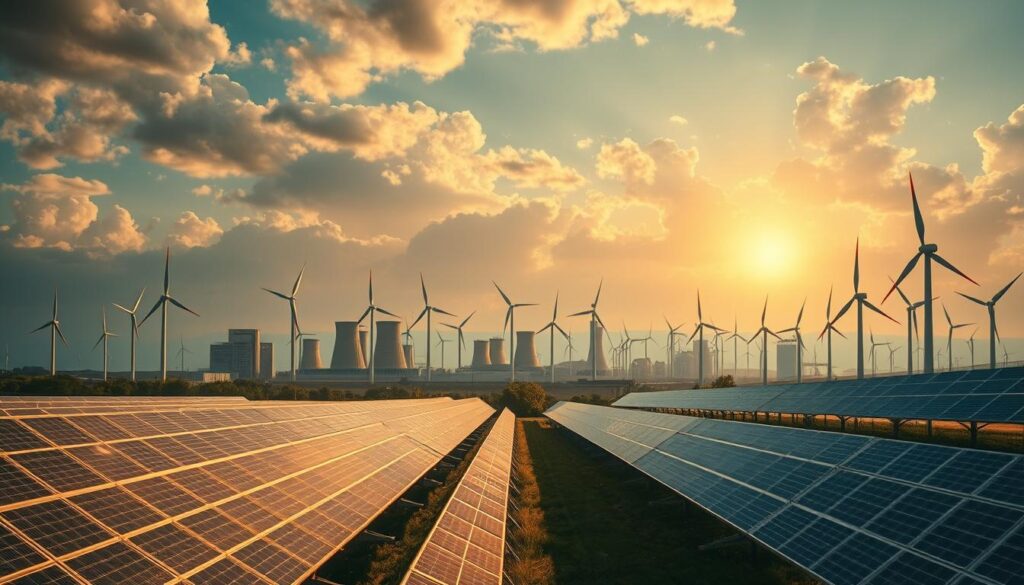
Advances in Solar and Wind Systems
Solar photovoltaic systems have seen dramatic improvements in efficiency. In 2024, solar energy added an estimated 39.6 gigawatts (GW) of capacity, compared to 27.4 GW in 20235. This growth is driven by innovations like concentrated solar power, widely used in Spain.
Wind turbine designs have also transformed. Onshore wind capacity grew by 5.3 GW in 2024, reaching a total of 153 GW5. South Africa’s wind energy projects showcase how modern turbines can maximize output while minimizing environmental impact.
Breakthroughs in Geothermal and Hydropower
Geothermal technologies, though currently generating only 0.4% of U.S. utility-scale electricity, are gaining traction5. Enhanced systems now tap deeper heat sources, offering consistent and reliable power.
Hydropower remains a cornerstone of clean energy. Modern solutions focus on reducing ecological disruption while increasing generation capacity. For example, the Vindeby Offshore Wind Farm in Denmark, installed in 1991, demonstrated the potential of large-scale hydropower projects6.
“Innovation in energy technologies is not just about efficiency—it’s about creating a sustainable future for all.”
Supporting infrastructure has also improved. Battery storage capacity nearly doubled in 2024, reaching 29 GW5. This ensures stable energy supply, even during peak demand.
These advancements have significantly reduced emissions and decreased reliance on fossil fuels. As a result, renewable technologies are now industry leaders, offering cleaner and more sustainable alternatives.
Harnessing Renewable Energy for a Low-Carbon Future
The shift to low-carbon solutions is reshaping global energy systems. By replacing oil-based systems with cleaner alternatives, we can significantly reduce greenhouse gas emissions. This transition is essential for achieving net-zero targets and combating climate change7.
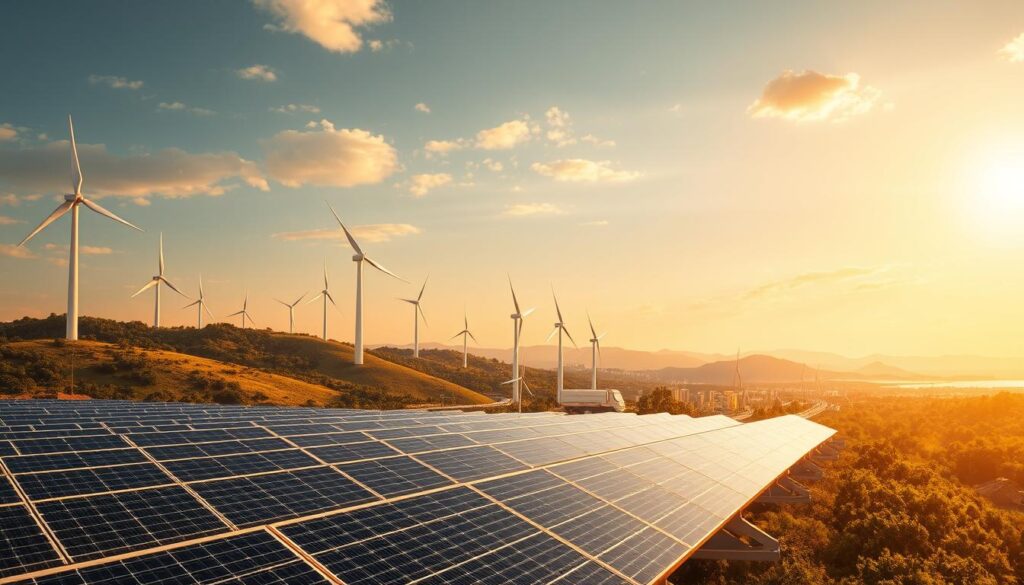
Clean power sources like wind solar are at the forefront of this transformation. These technologies not only displace fossil fuels but also convert waste heat into useful power. For example, 86% of newly commissioned clean power capacity in 2022 had lower costs than fossil fuel-fired electricity7.
Technical advancements are making this transition more practical. Energy storage systems, such as advanced batteries, ensure a stable supply even during peak demand. This infrastructure is crucial for integrating intermittent sources like wind and solar into the grid8.
“The transition to low-carbon energy is not just an environmental imperative—it’s an economic opportunity.”
Initiatives in the U.S. are paving the way for a sustainable future. Robust energy policies are encouraging investment in clean power, reducing reliance on oil, and improving energy security. For instance, Google aims to operate on 24/7 carbon-free energy by 20309.
By harnessing clean power, we can mitigate the impacts of climate change while creating economic opportunities. This forward-looking approach ensures a healthier planet and a more resilient energy system for future generations.
Integrating Clean Energy into the Global Energy Mix
The integration of clean power into global systems is transforming how we meet energy demands. As the world shifts towards sustainable solutions, challenges like intermittency and grid resilience must be addressed. These hurdles are being overcome through innovative storage systems and distributed generation, ensuring a stable and efficient energy supply10.
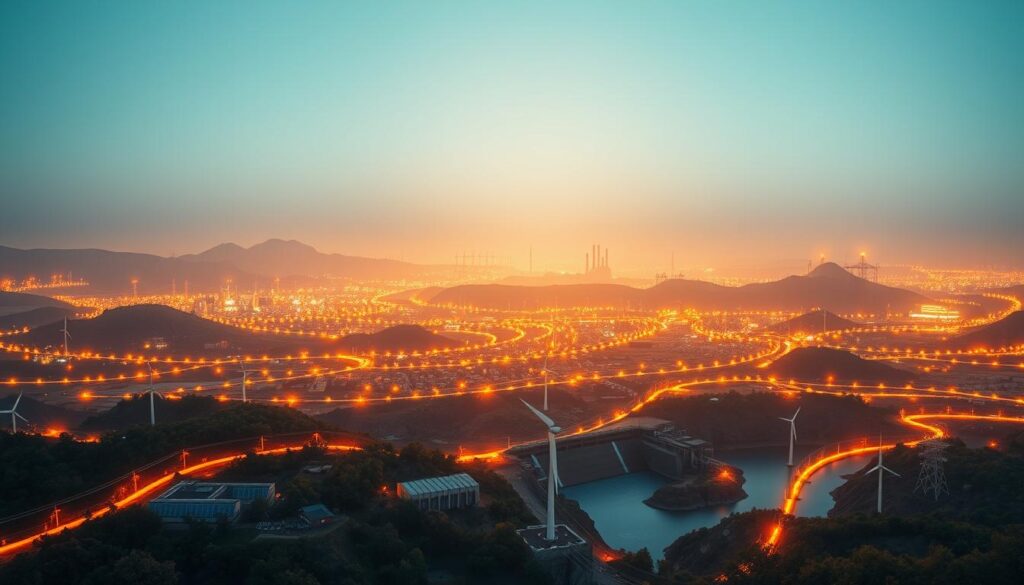
Intermittency Challenges and Energy Storage Solutions
One of the main challenges of clean power is its intermittent nature. Solar and wind systems depend on weather conditions, leading to fluctuations in energy production. To address this, advanced storage solutions like battery systems and pumped hydroelectric storage are being deployed11.
For example, battery storage capacity nearly doubled in 2024, reaching 29 GW. This ensures a consistent electricity supply, even during peak demand10. Pumped hydroelectric storage, which accounts for 95% of global storage capacity, remains a reliable solution for balancing supply and demand11.
Distributed Generation and Grid Resilience
Distributed generation systems, such as rooftop solar panels and small wind turbines, are enhancing grid resilience. These systems reduce reliance on centralized power plants and minimize transmission losses. In the United States, distributed generation has improved grid stability during extreme weather events10.
Smart grid technologies are also playing a crucial role. They enable real-time monitoring and management of energy flows, ensuring efficient use of resources. For instance, Mauritius installed an 18 MW battery storage system to support 50 MW of intermittent clean power, avoiding 81,000 tonnes of greenhouse gas emissions annually11.
“The future of energy lies in integrating diverse sources and leveraging technology for a resilient grid.”
| Storage Solution | Capacity | Key Benefit |
|---|---|---|
| Battery Systems | 29 GW (2024) | Stable supply during peak demand |
| Pumped Hydro | 95% of global storage | Balances supply and demand |
| Distributed Generation | N/A | Enhances grid resilience |
Biomass and other complementary resources are also vital for balancing the global energy mix. Biomass accounts for nearly 15% of the growth in clean power demand, providing a reliable backup for intermittent sources10. By integrating these solutions, we can create a more resilient and sustainable energy system for the world today and in the future.
Economic and Environmental Benefits of Clean Power
The economic and environmental advantages of clean power are reshaping industries and improving lives. By reducing reliance on fossil fuels, clean power systems are driving down costs, creating jobs, and improving public health. This dual benefit is transforming how we think about energy and its impact on the planet.
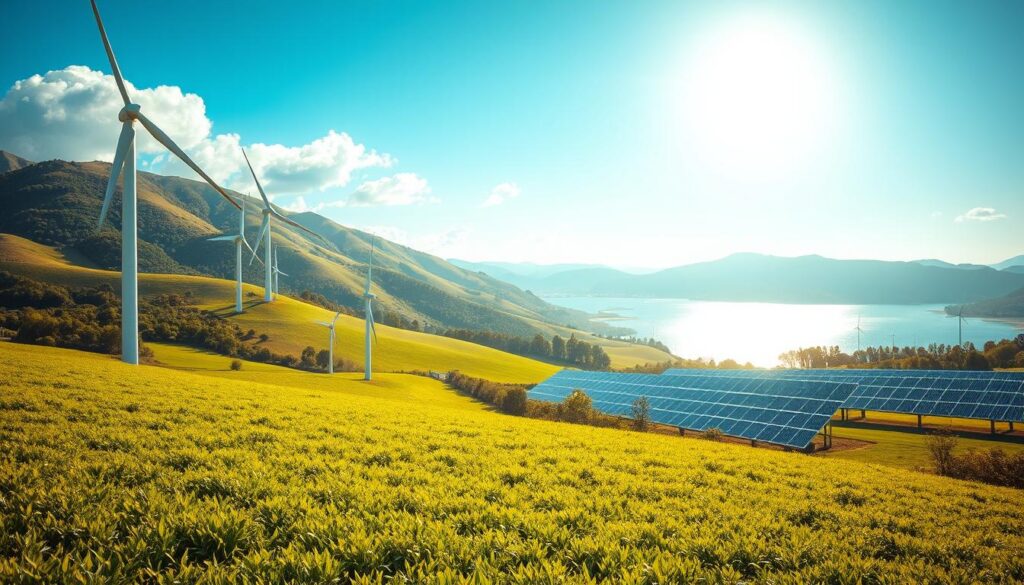
Cost Reduction Trends and Investment Insights
Clean power is becoming more affordable every year. Transitioning to these systems is projected to reduce U.S. wholesale electricity prices by 20% to 80% by 2040, depending on the region12. This cost reduction is attracting significant investment across various sectors. For example, clean energy contributed 10% to global GDP growth in 2023, amounting to around USD 320 billion13.
Investments in clean power are also creating jobs. The Inflation Reduction Act is expected to generate over 1.5 million new jobs in the U.S. over the next decade14. These jobs span manufacturing, installation, and maintenance, providing economic stability in regions that need it most.
Public Health Benefits and Emission Reductions
Clean power significantly reduces greenhouse gas emissions, improving air quality and public health. For instance, cooking with traditional biomass fuel causes about 4 million premature deaths annually, primarily in Asia and sub-Saharan Africa14. Transitioning to cleaner systems can mitigate these health risks.
Geothermal and wind energy are particularly effective in providing cost-effective heating solutions. A wind turbine in South Dakota produces about five times the power of a turbine in Florida, showcasing the efficiency of these systems12. These technologies not only reduce emissions but also lower energy costs for households and businesses.
“The transition to clean power is not just an environmental imperative—it’s an economic opportunity.”
By embracing clean power, we can stimulate economic growth while protecting the environment. This forward-looking approach ensures a healthier planet and a more resilient energy system for future generations.
Insights from Renewable Energy Journals and Research
Research from leading journals highlights how innovative solutions are transforming the way we approach resource management and climate challenges. These studies provide valuable insights into reducing reliance on coal and lowering gas emissions, paving the way for a sustainable future15.

Global Case Studies and Pilot Projects
Global case studies showcase how innovative projects are reshaping production and reducing environmental impact. For example, a pilot project in Germany reduced gas emissions by 30% through advanced wind turbine technology16. Similarly, a solar initiative in India increased resource efficiency by 25%, demonstrating the potential of clean power15.
These projects highlight the importance of technological advancements in achieving climate goals. By leveraging data-driven strategies, countries can optimize their energy systems and reduce reliance on coal17.
Emerging Trends and Data-Driven Innovations
Emerging trends in the sector indicate a shift towards sustainable production methods. For instance, the adoption of smart grids has improved energy distribution efficiency by 15%15. Additionally, advancements in battery storage have enhanced grid resilience, ensuring a stable energy supply16.
“Innovation in energy technologies is not just about efficiency—it’s about creating a sustainable future for all.”
Data-driven insights reveal that a 1% increase in technological innovation leads to a 0.33% rise in clean power use in the long run15. This underscores the critical role of research in driving future innovations and sustainable practices worldwide.
| Project | Location | Impact |
|---|---|---|
| Wind Turbine Pilot | Germany | 30% reduction in gas emissions |
| Solar Initiative | India | 25% increase in resource efficiency |
| Smart Grid Implementation | United States | 15% improvement in energy distribution |
These examples illustrate how global efforts are addressing climate challenges while improving production efficiency. By continuing to invest in research and innovation, we can achieve a cleaner, more sustainable future.
Overcoming Barriers and Policy Challenges
Policy challenges and economic barriers are slowing the transition to sustainable power systems. Fossil fuel subsidies and lobbying efforts remain significant obstacles, hindering the growth of solar power and hydropower. Addressing these issues is essential to accelerate the adoption of cleaner technologies and meet global climate goals18.

Addressing Fossil Fuel Subsidies and Lobbying
Fossil fuel subsidies distort the market, making it harder for solar power and hydropower to compete. In 2023, global subsidies for fossil fuels exceeded $7 trillion, creating an uneven playing field19. Lobbying efforts by traditional energy industries further complicate the transition, delaying policy reforms that could support cleaner alternatives.
Reforming subsidy policies is critical. For example, the European Union has begun redirecting funds from fossil fuels to renewable projects, aiming to triple its renewable capacity by 203018. Such initiatives highlight the need for systemic change to level the playing field.
“The transition to sustainable energy requires bold policy reforms and the phasing out of fossil fuel subsidies.”
Improving Regulatory Frameworks
Regulatory frameworks play a crucial role in supporting the transition. In the U.S., state-level policies vary widely, with California leading in renewable energy standards while others lag behind19. Streamlining regulations and creating consistent policies can help overcome these disparities.
For instance, Texas, a leader in wind energy, faces challenges in transferring power to neighboring states due to mismatched policies19. Addressing these issues requires collaboration between states and federal agencies to ensure a cohesive approach.
Strategies for Policymakers
Policymakers must prioritize reforms that support clean energy adoption. This includes investing in infrastructure, such as grid upgrades and energy storage, to accommodate intermittent sources like solar power and wind18. Additionally, public-private partnerships can mobilize resources and drive innovation.
Countries like Germany and India have successfully implemented policies that accelerate renewable adoption. Germany’s Renewable Energy Act and India’s International Solar Alliance are prime examples of effective strategies19.
Innovative Home and Community Renewable Energy Solutions
Innovative solutions are transforming how homes and communities generate and share power. From solar panels to small wind turbines, these technologies empower individuals to take control of their electricity generation while reducing reliance on centralized grids20.
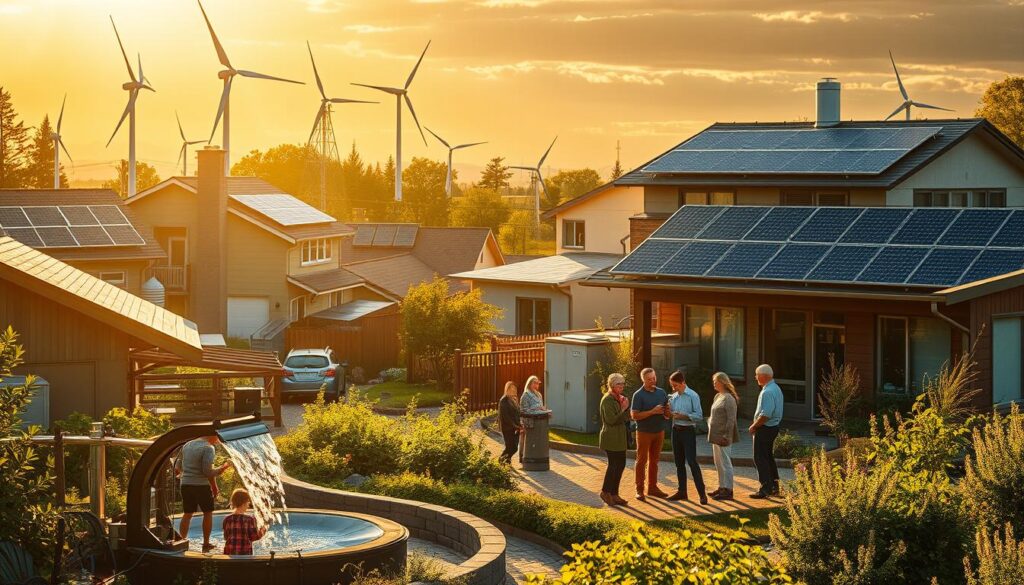
Residential Implementations: Solar, Wind, and Geothermal
Modern homes are increasingly adopting solar panels, small wind turbines, and geothermal systems. These technologies not only provide clean power but also offer long-term cost savings. For example, the SEIN initiative in Port Arthur, Texas, identified optimal locations for battery storage systems, enhancing energy resilience in underserved communities20.
Geothermal heat pumps are another effective solution, especially in regions with consistent underground temperatures. These systems use the earth’s natural heat to provide heating and cooling, reducing energy consumption by up to 50%21.
Community Grid Integration and Net Metering Strategies
Community grids are evolving to integrate distributed energy resources like solar and wind power. Net metering programs allow homeowners to feed excess electricity back into the grid, earning credits on their utility bills. This approach promotes energy sharing and efficiency20.
For instance, Entergy’s solar projects across Texas, Louisiana, and Arkansas have a combined capacity of 3,560 megawatts, showcasing the scalability of these solutions21. Advanced technology ensures seamless integration, optimizing energy flow and grid stability.
“The future of energy lies in empowering communities to generate and share power sustainably.”
These community-driven approaches are not just about energy independence—they are a step toward a more sustainable future. By leveraging innovative solutions, we can create resilient energy systems that benefit everyone.
Conclusion
The future of global power systems is being reshaped by innovative technologies and sustainable practices. Over the past year, advancements in clean power have significantly reduced emissions and reliance on fossil fuels, paving the way for a greener tomorrow22.
These technologies not only improve heat and electricity generation efficiency but also drive economic growth. For instance, clean energy roles now account for over 50% of global energy sector jobs, showcasing their transformative impact23.
Looking ahead, addressing policy challenges and investing in innovative solutions will be crucial. By enhancing energy consumption efficiency, we can create a more resilient and sustainable energy system for future generations24.
The progress made so far is promising, but continued research and investment are essential. Together, we can build a cleaner, healthier world powered by sustainable solutions.
FAQ
What is the definition of clean power?
How has the history of clean power evolved?
What are the latest advances in solar and wind systems?
What breakthroughs have occurred in geothermal and hydropower?
How does clean power contribute to a low-carbon future?
What are the challenges of integrating clean power into the grid?
How does distributed generation improve grid resilience?
What are the economic benefits of clean power?
How does clean power improve public health?
What insights can be gained from global case studies?
How can fossil fuel subsidies be addressed to promote clean power?
What are the benefits of residential solar and wind systems?
How does net metering support community clean power?
Source Links
- Why is renewable energy important? – REN21 – https://www.ren21.net/why-is-renewable-energy-important/
- The Role of Renewable Energy in a Sustainable Future – https://zeroe.io/blog/the-role-of-renewable-energy-in-a-sustainable-future
- Types of renewable energy – https://www.edfenergy.com/energywise/renewable-energy-sources
- Renewable Energy Explained – https://education.nationalgeographic.org/resource/renewable-energy-explained/
- US Clean Power Development Sees Record Progress, As Well As Stronger Headwinds – https://www.wri.org/insights/clean-energy-progress-united-states
- The history of renewable energy hits a modern renaissance – https://www.eib.org/en/essays/history-renewable-energy
- Renewable Energy vs. Low-Carbon Solutions | EquinorOut – https://www.equinorout.com/why-it-matters/renewable-energy-vs-low-carbon-solutions
- Renewable energy: Driving the transition to a sustainable world – https://www.iso.org/renewable-energy
- How companies can create a low-carbon energy future – https://www.intuition.com/how-companies-can-create-a-low-carbon-energy-future/
- Global overview – Renewables 2024 – Analysis – IEA – https://www.iea.org/reports/renewables-2024/global-overview
- What is the sustainable energy transition and why is it key to tackling climate change? | UNDP Climate Promise – https://climatepromise.undp.org/news-and-stories/what-sustainable-energy-transition-and-why-it-key-tackling-climate-change
- The economic impacts of clean power – https://www.brookings.edu/articles/the-economic-impacts-of-clean-power/
- Clean energy is boosting economic growth – Analysis – IEA – https://www.iea.org/commentaries/clean-energy-is-boosting-economic-growth
- Green Energy’s Impact on the Economy – https://www.business.com/articles/the-impact-of-green-energy-on-the-economy/
- Harnessing technological innovation and renewable energy and their impact on environmental pollution in G-20 countries – Scientific Reports – https://www.nature.com/articles/s41598-025-85182-0
- The Impact of Weather Variability on Renewable Energy Consumption: Insights from Explainable Machine Learning Models – https://www.mdpi.com/2071-1050/17/1/87
- Financing the future: insights into sustainable energy investments through scientific mapping and meta-analysis – Discover Sustainability – https://link.springer.com/article/10.1007/s43621-024-00788-0
- Unlocking renewable potential: Overcoming barriers to triple by 2030 | GHD – The Power of Commitment – https://www.ghd.com/en/insights/unlocking-renewable-potential-overcoming-barriers-to-triple-by-2030
- PhiCap – https://www.phicapadvisors.com/news-insights/the-policy-barriers-impeding-the-energy-transition-and-how-to-overcome-them
- These Innovative Approaches Harness the Benefits of Rooftop Solar Energy for Homes and Small Businesses – https://www.nrel.gov/news/program/2025/these-innovative-approaches-harness-the-benefits-of-rooftop-solar-energy-for-homes-and-small-businesses.html
- Entergy Corporation – https://www.entergy.com/renewable-energy/
- Renewable energy – https://en.wikipedia.org/wiki/Renewable_energy
- Renewable Energy Advantages & Disadvantages | IBM – https://www.ibm.com/think/insights/renewable-energy-advantages-disadvantages
- What is the Role of Renewable Energy in Achieving U.S. Energy Independence? – https://blinkcharging.com/blog/what-is-the-role-of-renewable-energy-in-achieving-us-energy-independence
